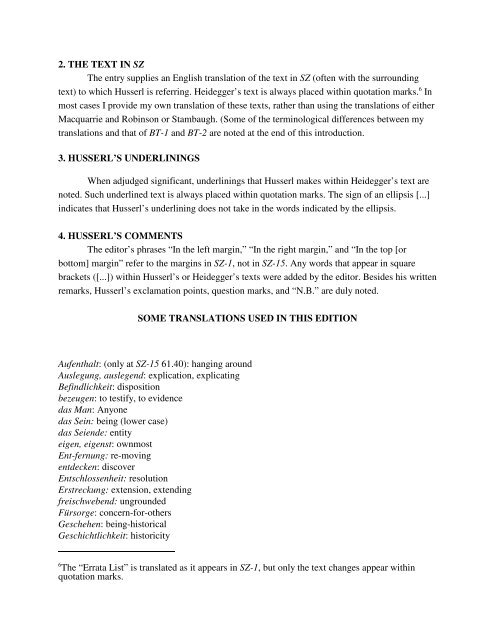Marginalia to Being and Time - Religious Studies at Stanford ...
Marginalia to Being and Time - Religious Studies at Stanford ...
Marginalia to Being and Time - Religious Studies at Stanford ...
Create successful ePaper yourself
Turn your PDF publications into a flip-book with our unique Google optimized e-Paper software.
2. THE TEXT IN SZ<br />
The entry supplies an English transl<strong>at</strong>ion of the text in SZ (often with the surrounding<br />
text) <strong>to</strong> which Husserl is referring. Heidegger’s text is always placed within quot<strong>at</strong>ion marks. 6 In<br />
most cases I provide my own transl<strong>at</strong>ion of these texts, r<strong>at</strong>her than using the transl<strong>at</strong>ions of either<br />
Macquarrie <strong>and</strong> Robinson or Stambaugh. (Some of the terminological differences between my<br />
transl<strong>at</strong>ions <strong>and</strong> th<strong>at</strong> of BT-1 <strong>and</strong> BT-2 are noted <strong>at</strong> the end of this introduction.<br />
3. HUSSERL’S UNDERLININGS<br />
When adjudged significant, underlinings th<strong>at</strong> Husserl makes within Heidegger’s text are<br />
noted. Such underlined text is always placed within quot<strong>at</strong>ion marks. The sign of an ellipsis [...]<br />
indic<strong>at</strong>es th<strong>at</strong> Husserl’s underlining does not take in the words indic<strong>at</strong>ed by the ellipsis.<br />
4. HUSSERL’S COMMENTS<br />
The edi<strong>to</strong>r’s phrases “In the left margin,” “In the right margin,” <strong>and</strong> “In the <strong>to</strong>p [or<br />
bot<strong>to</strong>m] margin” refer <strong>to</strong> the margins in SZ-1, not in SZ-15. Any words th<strong>at</strong> appear in square<br />
brackets ([...]) within Husserl’s or Heidegger’s texts were added by the edi<strong>to</strong>r. Besides his written<br />
remarks, Husserl’s exclam<strong>at</strong>ion points, question marks, <strong>and</strong> “N.B.” are duly noted.<br />
SOME TRANSLATIONS USED IN THIS EDITION<br />
Aufenthalt: (only <strong>at</strong> SZ-15 61.40): hanging around<br />
Auslegung, auslegend: explic<strong>at</strong>ion, explic<strong>at</strong>ing<br />
Befindlichkeit: disposition<br />
bezeugen: <strong>to</strong> testify, <strong>to</strong> evidence<br />
das Man: Anyone<br />
das Sein: being (lower case)<br />
das Seiende: entity<br />
eigen, eigenst: ownmost<br />
Ent-fernung: re-moving<br />
entdecken: discover<br />
Entschlossenheit: resolution<br />
Erstreckung: extension, extending<br />
freischwebend: ungrounded<br />
Fürsorge: concern-for-others<br />
Geschehen: being-his<strong>to</strong>rical<br />
Geschichtlichkeit: his<strong>to</strong>ricity<br />
6 The “Err<strong>at</strong>a List” is transl<strong>at</strong>ed as it appears in SZ-1, but only the text changes appear within<br />
quot<strong>at</strong>ion marks.


